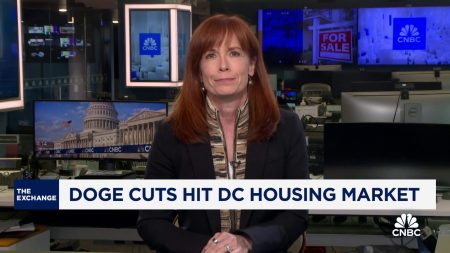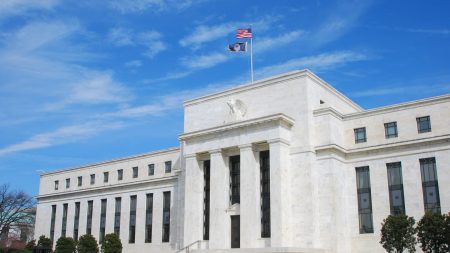Navigating Market Uncertainty: Opportunities for Fixed-Income Investors
Understanding the Current Landscape
The financial markets are currently shrouded in uncertainty, with bond yields at elevated levels as investors try to make sense of the direction of interest rates and inflation. The yield on the 10-year Treasury note is hovering around 4.47%, a significant increase from recent years. This rise in yields means that bond prices are lower, as yields and prices move inversely. The Federal Reserve, after cutting rates last year, decided to keep them unchanged in January, signaling a pause in its monetary policy. According to the CME FedWatch Tool, most market participants believe that the central bank will not lower rates again for several months. Federal Reserve Chair Jerome Powell recently testified before Congress, stating that "we’re not quite there yet" in achieving the Fed’s 2% inflation target. This uncertainty creates both challenges and opportunities for fixed-income investors, particularly those who remain agile and proactive in their investment strategies.
Balancing Defensive and Growth-Oriented Strategies
To capitalize on the opportunities arising from this uncertainty, Wells Fargo suggests adopting a dual approach: combining defensive and growth-oriented fixed-income strategies. This balanced approach allows investors to navigate the risks associated with interest rate fluctuations and inflation while still seeking attractive returns. As noted by Luis Alvarado, a global fixed-income specialist at Wells Fargo, "Ultra-short-term securities may appear attractive, but those opportunities diminish if the Fed eventually cuts policy rates further, while longer-term securities can be exposed to interest-rate risk if inflation and hotter economic growth force the Fed to raise rates further." Therefore, it is crucial for investors to carefully consider their investment horizons and risk tolerances when selecting fixed-income securities.
U.S. Intermediate-Term Taxable Bonds: A Balanced Option
One of the key opportunities identified by Alvarado is U.S. intermediate-term taxable bonds, which have maturities ranging from three to seven years. These bonds strike a balance between yield and price volatility, making them an attractive option for investors seeking stability without sacrificing returns. As Alvarado points out, "This asset class may provide investors with opportunities to outperform cash, cash alternatives, and U.S. Short Term Taxable Fixed Income in the near term." Historically, intermediate-term bonds have been less sensitive to interest rate changes, which makes them a safer bet if rates were to increase further. With attractive yields and relatively lower risk, these bonds are an excellent choice for investors looking to diversify their portfolios.
U.S. Long-Term Taxable Bonds: Leveraging Yield Steepness
Another opportunity lies in U.S. long-term taxable bonds, particularly those with maturities of 10 years or more. While Alvarado has a neutral rating on this asset class, he suggests that investors could benefit from targeting long-term bonds to take advantage of the current yield curve steepness. The yield curve, which plots the interest rates of bonds with different maturities, is currently steep, meaning that long-term bonds offer significantly higher yields than short-term ones. By focusing on the long end of the curve, investors can lock in higher yields while the Fed appears to be pausing its rate-cutting cycle. This strategy could prove particularly advantageous if inflation remains elevated and the Fed is forced to raise rates again in the future.
Investment-Grade Corporate Bonds: Selectivity is Key
Investment-grade corporate bonds are another area of opportunity, albeit with some caveats. Credit spreads, which measure the difference between the yield of corporate bonds and that of comparable government bonds, are currently tight, indicating that these bonds are relatively expensive. However, the higher yields offered by corporate bonds compared to other investment-grade fixed-income sectors make them a favorable investment for those willing to conduct thorough credit analysis. Alvarado emphasizes the importance of selectivity among issuers and sectors, advising investors to focus on high-quality borrowers with strong financial fundamentals. Additionally, liquidity should be a key consideration, as it can impact an investor’s ability to buy or sell bonds quickly without significantly affecting their price.
Securitized Products and Emerging Market Fixed Income
Securitized products, such as residential mortgage-backed securities (RMBS) and asset-backed securities (ABS), also offer value for fixed-income investors. These securities provide favorable credit quality and liquidity, making them attractive alternatives to other fixed-income investments. Alvarado notes that RMBS, in particular, offer advantages over investment-grade corporate bonds due to their credit-spread differentials. Additionally, demand for ABS remains strong, and while credit spreads have compressed in recent months, there is still room for them to tighten further, potentially leading to higher returns for investors. Turning to emerging markets, both U.S.-dollar and local currency emerging-market sovereign bonds are expected to perform well in the near term, supported by the likelihood of further Fed rate cuts. The attractive yield differential of these bonds can provide a cushion against potential capital losses if interest rates rise or credit spreads widen.
Municipal Bonds: A Tax-Efficient Option
Finally, municipal bonds remain an attractive option for high-income investors due to their tax advantages. These bonds are free from federal tax and, in some cases, state tax as well, making them a valuable addition to a diversified investment portfolio. While other fixed-income sectors may offer higher yields, the tax-exempt nature of municipal bonds can enhance after-tax returns, making them a desirable choice for investors in higher tax brackets. Alvarado highlights the strong fundamentals of municipal bonds, noting that they continue to play an important role in portfolio construction for those seeking tax-efficient income.
In conclusion, while the current market environment presents challenges for fixed-income investors, it also offers several opportunities for those who are willing to remain agile and adopt a balanced investment approach. By carefully considering their investment horizons, risk tolerances, and the specific characteristics of different bond sectors, investors can navigate the uncertainty and achieve their financial goals. Whether through intermediate-term taxable bonds, long-term taxable bonds, investment-grade corporate bonds, securitized products, emerging market fixed income, or municipal bonds, there are numerous ways to capitalize on the opportunities available in the fixed-income market today.









